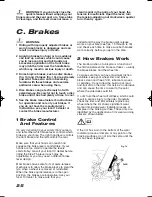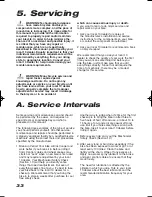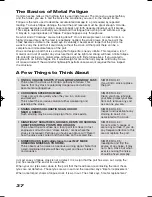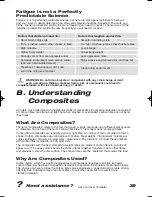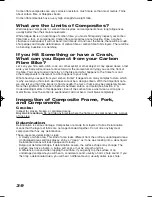
Carbon fibre composites are very corrosion resistant, much more so than most metals. Think
about carbon fibre or fibreglass boats.
Carbon fibre materials have a very high strength-to-weight ratio.
What are the Limits of Composites?
Well designed “composite” or carbon fibre bicycles and components have long fatigue lives,
usually better than their metal equivalents.
While fatigue life is an advantage of carbon fibre, you must still regularly inspect your carbon
fibre frame, fork, or components. Carbon fibre composites are not ductile. Once a carbon
structure is overloaded, it will not bend; it will break. At and near the break, there will be rough,
sharp edges and maybe delamination of carbon fibre or carbon fibre fabric layers. There will be
no bending, buckling, or stretching.
If you Hit Something or have a Crash,
What can you Expect from your Carbon
Fibre Bike?
Let’s say you hit a kerb, ditch, rock, car, other cyclist or other object. At any speed above a fast
walk, your body will continue to move forward, the momentum carrying you over the front of
the bike. You cannot and will not stay on the bike and what happens to the frame fork and
other components is irrelevant to what happens to your body.
What should you expect from your carbon frame? It depends on many complex factors, which
is why we tell you that crash worthiness cannot be a design criteria. With that important note,
we can tell you that if the impact is hard enough, the fork or frame may be completely broken.
Note the significant difference in behavior between carbon and metal (see Section 2. A,
Understanding metals in this Appendix). Even if the carbon frame was twice as strong as a
metal frame, once the carbon is overloaded it will not bend, it will break completely.
Inspection of Composite Frame, Fork,
and Components
Cracks:
Inspect for cracks, broken, or splintered areas.
Any crack is serious.
Do not ride any bicycle where the frame or any component has a crack
of any size.
Delamination:
Delamination is serious damage. Composites are made from layers of fabric. Delamination
means that the layers of fabric are no longer bonded together. Do not ride any bicycle or
component that has any delamination.
These are some delamination clues:
• A cloudy or white area. This kind of area looks different from the ordinary undamaged areas.
Undamaged areas will look glassy, shiny, or “deep,” as if one was looking into a clear liquid.
Delaminated areas will look opaque and cloudy.
• Bulging or deformed shape. If delamination occurs, the surface shape may change. The
surface may have a bump, a bulge, soft spot, or not be smooth and fair.
• A difference in sound when tapping the surface. If you gently tap the surface of an
undamaged composite you will hear a consistent sound, usually a hard, sharp sound. If you
then tap a delaminated area, you will hear a different sound, usually duller, less sharp.
39
13
owners manual GENERIC A5 aw
05/05/14
10:25 Page 41

